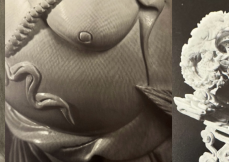
THE MANDARIN GARNET OR SPESSARTITE | FR
The Mandarin garnets belong to the spessartite group, one of the six varieties of the garnet family. They are rarer than the other species. This variety owes its name to the first known mine, in the Spessart, on the River Elbe, in Bavaria. At the beginning of the 1990S, two orange spessartite garnet mines were discovered in the north west of Namibia, near the border with Angola. There, in the Kakoaland, one thousand kilometres away from Windhoek, the climate IS very arid. Such mines produced stones of an iniquitous colour, caused by strong manganese content Other sites had already been discovered in Sri lanka, Brazil, the United States, Sweden, Madagascar, as well as in India, in Narukot, in the province of Bombay The first Namibian mine was soon mined out The second one produced no more than 189 kg of rough stone, overall, between1995 and 1999•
In 1999, new discoveries of spessartite garnets were announced in Niger, more particularly. The stones which originate from there, are called Mandarin garnets and this trade name can only be given to the Namibian garnets only. If the spessartites from Nigeria are often purer and have a more defined orange colour - called Fanta - they, however, do not have this silky aspect which is characteristic of the Namibian Mandarin garnet Seeing its quality and its scarcity, it is quite common to say that the Mandarin garnet is for the spessartite garnets what the Kashmir sapphire is to sapphires.
In fact, garnet is not really a mineral, but more a group of similar minerals, known as "group of garnets". All the garnets are silicates which are different in their chemical compositions, but have similar atomic structures. Garnets are found in various diversities of colours, from green to violet, from brown to red and, even sometimes in colours which change according to the light - a change owed to a mixture on the crystallographic scale. The pyrope spessartites from Tanzania are the most sought after by collectors, owing to their scarcity and their beauty. The Mandarin garnet is a rare species of garnets and it may vary from reddish brown to orange yellow Its hardness is 7 to 7.5 - harder than iron - and does not show any cleavage plane. Set on an item of jewellery, it offers a very good resistance and requires very little care.
The spessartite garnets are also mined in Pakistan, Madagascar, Kenya, Virginia and California. Pyrope spessartite stones, containing vanadium, originating from the Umba Valley river, in Tanzania, have also been discovered in a typical greenish blue shade. Historically, it is the mica granite of Stengerts, in Aschaffenburg, that spessartites used to be found. In the 18tr century they already had a nice brown-red There is also mention of some in the granites In San Piero on the island of Elba. Other sites have also been reported in France, in Italy, in Norway, In Sweden, in Scotland and in the Oural.
The gems are not normally heated or irradiated so that they may be sold without too much risk. Yet, unfortunately, It is easy to clone them In coloured glass or in Yag - imitation of the diamond in the 1960s - with dye added. The first successful synthesis goes back to 1883.
No other stone has such vivid orange shade saturation. A Mandarin garnet must be of an electric orange shade. The Mandarins are not generally brown. The stones are similar to the orange colour of the high quality spinels from Burma, but the shade is sometimes lighter. It also looks like a high range orange sapphire, better known as Padparadscha. Generally speaking, the mandarins tend to be exactly of the same colour and shade combinations as this rare sought after stone. The only real difference in quality amongst such precious stones is the quantity of inclusions in the stone. The stones are often eye-clean, even if certain stones present inclusions which may be seen Even the best gems have inclusions, but hard to see to the naked eye. Such amphibole inclusions (actinolite) enable the light to reflect in it, giving a particular shimmer to these garnets. Yet, amongst the spessartites, there are surprisingly pure crystals. Some traditional inclusions should also be mentioned: small fluid inclusions in irregular shapes. Sometimes, small crystals of various origins of the mineral assemblage as well as two phased inclusions may be seen.
|










